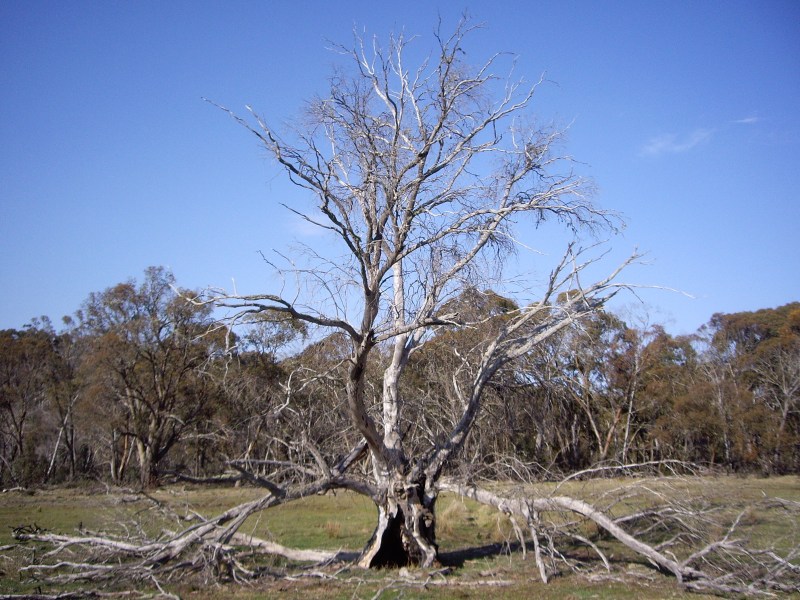The picture above is of a dead tree in 2007, along the road to the ski resort I have been working for every Winter since. The reason I took that picture is that I was drawn to it because of its balanced look and almost perfect shape, despite having died probably many years prior. It seemed that time had not touched it much since, leaving me to enjoy this amazing natural sculpture. It was almost like it spoke to me on a subtle level, taking me on a journey in my mind.
I cannot help and wonder what that tree has seen passing while it was alive, from the old prospectors looking for gold, the old coach that connected the small villages on both sides of the mountain range, to the first snow enthusiasts that went up on horseback and traversed the mountains on foot in search of the perfect powder stash to slide down.
Next came the road workers that turned this slick muddy track into a more user-friendly road. Development was not far behind with the first basic lodges being build and ski lifts being installed.
Nowadays there is a bustling ski resort attracting thousands of visitors every year, who probably pass this tree not even noticing it being there, in their rush to get to their destination in anticipation of some rails, jumps, turns and party time…
The next time I felt like taking a picture of this tree again was during a snow shower on my way to work in 2010, when the light just seemed perfect to highlight the beauty of this old dead tree with the snowfall adding to the feelings of magic this tree stirred in me.
Not much seemed to have changed in the last three years and again I stood still and admired it for a brief moment. How long had it been standing there before it spoke to me the first time? When had it died and why? Was it old age, maybe drought or disease had made it to what was left, or had it been affected by the bushfires visiting this area on a regular basis or a lightning strike?
In 2012 it started to show that even dead trees are not immune to the wear and tear of time as branches keep snapping during every storm that passes, leaving it noticeably bearer than when I saw it for the first time, five years prior.
This makes me ponder about the thoughts this tree has put into my mind over time and continues to do, which brings me to the following verse that ‘jumped’ out (not unlike this tree), when looking at the Dao Te Ching for more understanding about the most recent atrocities in the world.
Verse 76, Dao Te Ching:
Men are born soft and supple;
dead, they are stiff and hard.
Plants are born tender and pliant;
dead, they are brittle and dry.
Thus, whoever is stiff and inflexible is a disciple of death.
Whoever is soft and yielding is a disciple of life.
The hard and stiff will be broken.
The soft and supple will prevail.
When I read this verse, a memory came to me suddenly about an elderly Shaolin monk performing his daily stretching routine on a stage during their show in Melbourne, many years ago. (more about this in my book) His message really hit me at that time as my age was already showing a few minor signs of leaving youth behind in the not so far foreseeable future.
He said that by stretching every day, he kept his old body soft and supple, to avoid becoming brittle and break limbs. He metaphorically compared it with a young sapling that bends with the breeze, whereas an old tree becomes brittle and the branches snap!
Had he maybe studied this old book, written by Lao Tsu over 3000 years ago, and taken this verse as advise on staying healthy in old age? Is it just meant physically? Or could there be a psychological truth behind it too? Is it maybe a combination of both that is the secret to a healthy and active old age? Is there an even deeper layer to the meaning of this verse that points to the way countries are run?
Whatever it all means, I know that regular stretching, ever since watching the elderly monk and taking in his advice, has kept my body flexible and supple as well as developed better coordination and strength. This in turn has contributed to feeling better, younger and more vibrant now in my late forties compared to when I was in my twenties! Time will tell if it is still beneficial for me when I get to the age where a lot of people really start struggling with their bodies not cooperating, but I have a feeling that it will be from what I saw the monk do! Whatever is going to happen, for the moment I like to stick to my daily stretching routine and hold onto my dream of getting a free season pass for the ski lifts when I turn 70 and become an elderly “ski bum”!
By then the old tree will be probably be reduced to a pile of timber, covered in moss, providing a home for small animals and fungi. Will it still hold stories and provoke thoughts, or will they too have been nibbled away by the small creatures that keep nature in balance?
Is there anyone else out there that has an appreciation and fascination for dead trees? Please share your thoughts in the comments below!
PS: If you have downloaded my book and like my stories, I would appreciate it if you take a moment to leave a short review on Amazon!
With Gratitude,
Pollyesther




